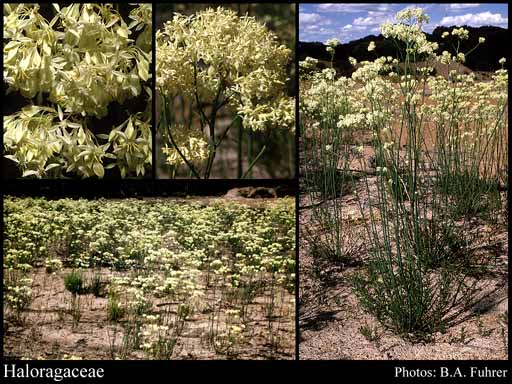- Reference
- Voy.Terra Austral. 2:549 (1814)
- Name Status
- Current







Scientific Description
Common name. Raspwort Family.
Habit and leaf form. Herbs (mostly), or shrubs, or ‘arborescent’ (Haloragodendron). Stem growth not conspicuously sympodial (monopodial). Hydrophytic to helophytic, or mesophytic; the aquatics rooted. Leaves of hydrophytes submerged and emergent. Heterophyllous (aquatic members with submerged leaves dissected and emergent leaves more or less entire), or not heterophyllous (when not aquatic). Leaves alternate, or opposite, or whorled; when alternate, spiral; petiolate to sessile; non-sheathing; simple, or compound (very varied in form); epulvinate; when compound, pinnate. Leaf blades dissected, or entire; when simple/dissected, pinnatifid, or palmately lobed; one-veined, or pinnately veined. Leaves without stipules. Stem anatomy. Secondary thickening absent, or developing from a conventional cambial ring.
Reproductive type, pollination. Fertile flowers hermaphrodite, or functionally male and functionally female, or hermaphrodite, functionally male, and functionally female. Unisexual flowers present, or absent. Plants hermaphrodite, or monoecious, or polygamomonoecious. Anemophilous.
Inflorescence and flower features. Flowers solitary, or aggregated in ‘inflorescences’; in spikes (usually). Inflorescences pseudanthial (at least, some forms sometimes considered so), or not pseudanthial. Flowers bracteolate (often), or ebracteolate; minute to small; regular (usually); (2–)4 merous; cyclic; tetracyclic, or pentacyclic. Free hypanthium absent. Perianth with distinct calyx and corolla, or sequentially intergrading from sepals to petals, or vestigial to absent; when present, 4, or 8; 2 -whorled, or 1 -whorled (C sometimes absent); isomerous; free. Calyx 2, or 4; 1 -whorled; polysepalous; valvate; exceeded by the corolla, or more or less equalling the corolla; regular; persistent. Corolla when present, 2, or 4; 1 -whorled; polypetalous; regular. Fertile stamens present, or absent (female flowers). Androecium 8, or (3–)4. Androecial members free of the perianth; all equal; free of one another; 1 -whorled, or 2 -whorled. Androecium exclusively of fertile stamens. Stamens 3–4, or 8; isomerous with the perianth, or diplostemonous; alternisepalous (when two-whorled), or oppositisepalous; filantherous (with rather large anthers). Anthers basifixed; non-versatile; dehiscing via longitudinal slits; latrorse; tetrasporangiate; appendaged (apiculate), or unappendaged. Fertile gynoecium present, or absent (male flowers). Gynoecium (2–)3–4 carpelled. The pistil (1–)3–4 celled. Gynoecium syncarpous; synovarious; inferior. Ovary (pseudo-) unilocular, or plurilocular; (1–)3–4 locular (partitions sometimes incomplete or more or less absent). Epigynous disk absent. Gynoecium stylate. Styles (2–)3–4 (feathery); free; apical. Stigmas dry type; papillate; Group II type. Placentation apical. Ovules in the single cavity (Glischrocaryon) 4; 1 per locule; pendulous; anatropous.
Fruit and seed features. Fruit non-fleshy; indehiscent, or a schizocarp. Mericarps when schizocarpic, comprising nutlets (e.g. Myriophyllum). Fruit when non-schizocarpic, a drupe, or a nut. The drupes with separable pyrenes. Seeds more or less copiously endospermic. Endosperm oily. Cotyledons 2. Embryo achlorophyllous (1/1); straight. Seedling. Germination phanerocotylar.
Geography, cytology, number of species. World distribution: cosmopolitan. X often = 7. 120 species.
Economic uses, etc. Myriophyllym is used for ponds and aquaria, and important in limnological conservation.
Keys
Western Australian Genera and Families of Flowering Plants — an interactive key
T.D. Macfarlane, L. Watson, N.G. Marchant